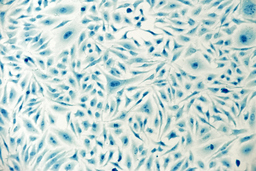A Surface Tension Mediated Lyoprocessing Technique for Preservation of Biologics
TECHNOLOGY NUMBER: 6849

OVERVIEW
A new method for storage and transportation of mammalian cell lines- Employs the use of trehalose to dry cells into a uniform desiccated matrix
- Permits storage at ambient temperatures without the need for cryopreservation
BACKGROUND
Cell-based manufacturing is a major source of protein therapeutics for a variety of illnesses. The isolation and maintenance of mammalian cell lines are particularly important in this setting due to their biological closeness to human cells. The storage and protection of mammalian cell lines is more difficult than circumstances involving bacteria or yeast. These cell lines are most commonly frozen in cryovials and stored in liquid nitrogen or freezers set to -80°C to maintain long term cell integrity and viability. However, these existing cryopreservation methods are complex to perform and costly to maintain over the long term. Even the smallest change in temperature from tightly defined constraints can cause cell degradation or death. Given the large and growing market for cell-based medical therapeutics that uses living cells to produce biologic compounds, a need exists for improved methods of cell line protection and storage.
INNOVATION
Researchers have created a method to dry specifically prepared mammalian cells that allows for efficient and inexpensive storage at ambient temperatures without compromising cell viability. This new technique employs a Chinese Hamster Ovary (CHO) cell line designed to work with trehalose, a sugar that prevents mammalian cell damage under anhydrous conditions. This novel cell line is called CHO-TRETn1 and expresses a trehalose transporter protein that helps move trehalose into the cell cytoplasm. The study cells are dip-coated in a trehalose solution during a drying procedure, creating a uniformly desiccated matrix of cells which maintain a 94% survival rate. The resulting matrix can simply be stored at ambient temperatures until they are rehydrated when they are needed again. The uniformity of the results suggests that the approach may prove especially useful as a source material in plug flow bioreactor manufacturing. Overall, this invention permits lower storage and transportation costs for mammalian cell lines used in the research and manufacture of recombinant protein and other biologic therapeutics.